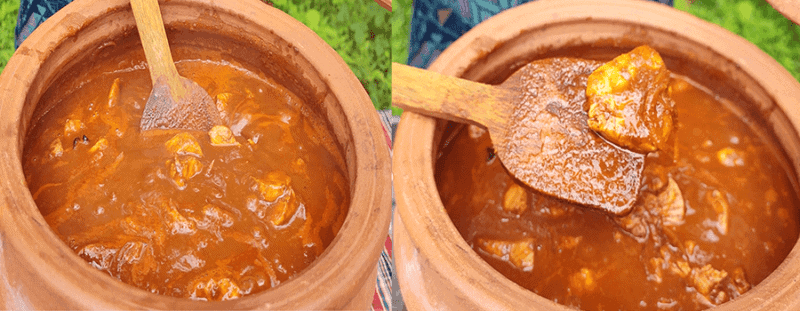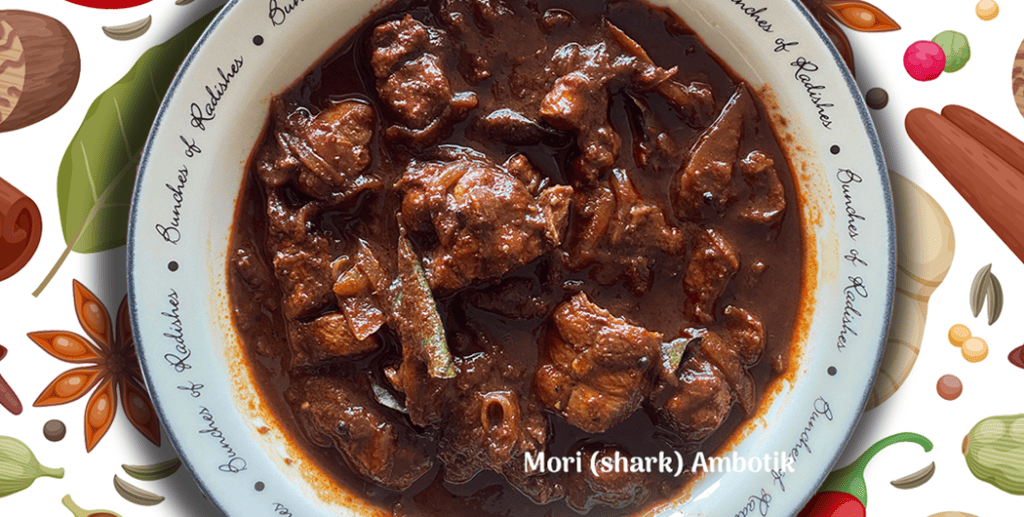Ambot means sour and tik means spicy in the Konkani language, spoken in Goa. Mori is a shark. Ambotik made with Mori is a delicious and unique Goan preparation that has come to be widely recognised, along with a handful of others, as the flag bearers of classic Goan cuisine. Immensely popular, commonly available, and easily identified by its red coloured gravy, Ambotik curries have a special place in the hearts of both Goemkars (Goans) and non-Goans alike. It’s also popular along the Konkan region that hugs the west coast of India. Mori Ambotik, known to visitors and tourists to Goa as Goan Shark Curry is staunchly traditional and an indispensable classic, but Ambotik curries with mackerel, sardine, kingfish, prawns, and even chicken are popular today. Ambotik with vegetables like Jackfruit is also not unheard of.
Aamso Tiksso is the ethnic ancestral name for Ambotik, and our masala is an exquisite and meticulous blend of local Goan spices in exact proportions that maintain the integrity of flavour and aroma, and consistency of gravy that’s unique to Ambotik curries, and impart the unmistakable red colour and the delicate balance of sourness and heat to this quintessential Goan dish. The following step by step illustrated method will lead you to the perfect preparation of Mori Ambotik, or Shark Ambotik, an iconic dish of the Hindu community, the way it continues to be made in Goan homes generation after generation. Like all our other masalas, this masala too does all the hard work, needing very little added ingredients, and makes Goan food accessible, desirable and simple to make, allowing you to be not only an expert in Goan cooking without spending too much time in the kitchen but also a connoisseur of traditional Goan cuisine. Enjoy.
What you need:
- Shark: 1 Kg (2.2 pounds)
- Red onion: 1 large
- Kokum (Garnicia Indica) only if you need the curry to be more sour: 3-4 pieces
- Water: 1 Cup (250 ml)
- Salt to season and taste
- The Women of Fatorda Aamso Tiksso masala.

Preeti Naik
This recipe for Mori Ambotik is from Preeti Naik from the locality of Agalli in Fatorda. An all time favourite of the Hindu community, this recipe has been part of her family for many many years.
Step 1 – The shark slices should be about half an inch thick, cleaned, and the excess water removed. Sprinkle some salt all over the slices and keep them aside for at least 10 minutes. The salt will draw out the moisture in the fish and reabsorb it with the salt, seasoning the fish inside out. The more you keep, the better it is.

Step 2 – Heat 2 tablespoons of oil—you can use any oil but traditionally, coconut oil is the standard––in a deep bottomed vessel and then add 1 big onion, thinly sliced. Though the red onion can be substituted with white, red is preferred and traditionally used in Goan cuisine as in most Indian cooking. It has a stronger flavour and thicker flesh that makes it ideal for thicker gravies.

Step 3 – Fry the onions until they become tender and translucent, and lightly browned. Stir continuously. This should take about 5 to 7 minutes. Adding a pinch of salt here will hasten the frying process, as it draws out the moisture and brown the onion. But be aware of how much salt you add totally to the preparation.

Step 4 – Now, add The Women of Fatorda Aamso Tiksso masala. For one kilo of Mori, with sufficiently thick gravy, about 4 to 5 teaspoon heaps of the masala will suffice. But the amount of gravy and its consistency is a matter of personal preference; so just go by the thumb rule that the more the masala, the thicker the gravy.

Step 5 – Fry the masala for about a minute, stirring constantly, as it mixes with the fried onion. You can reduce the flame to medium so that the masala does not get burned inadvertently. Add a cup of warm water. Mix well.

Step 6 – Bring the mixture to a simmer. Then cover the vessel and let it boil for about 2 to 3 minutes.

Step 7 – Remove the lid, and by this time, the gravy would have formed. This is a good time to adjust the salt too. Then add the shark slices one by one.

Step 8 – Give it a careful mix to make sure that all the slices are submerged in the gravy. Do not stir with a spoon or ladle after this lest it breaks the fish.

Step 9 – You can add the kokum pieces now. You’ll find that our masala has exquisitely balanced the sourness and spiciness to give you the classic taste of Ambotik curries but if you personally prefer the sourness to have an edge, the addition of kokum will do the trick. It’s not necessary unless you prefer. Replace the lid.

Step 10 – Allow the fish to cook for about 5-8 minutes. If you find the gravy to be watery, bring it to the right consistency by keeping the vessel open.

Step 11 – Check whether the fish is done. The pieces would have turned white and would be firm to the touch.

Step 12 – Your classic Goan preparation of Mori Ambotik is ready. You can serve it in the traditional fashion with Poi (Goan bread).

NOTE – Though this is an ancient masala recipe, and the traditional method for preparing Mori Ambotik, you can experiment with variations depending on your taste and preferences. For example, no garnishing is done on the classic dish but you can try chopped fresh coriander leaves or even curry leaves creating a slight twist in aroma and taste. Also, for those who prefer more heat, a couple of green chillies slit lengthways can be added. The best accompaniment with Mori Ambotik is also a matter of taste and preference. Traditionally Goan rice or Poi (Goan bread) is served alongside. There are many kinds of Goan breads too. Now that you’ve made Mori Ambotik the traditional way, please go ahead and experiment with our masala to create your own variations. You imagination is the only limit. Do let us know of your efforts at [email protected] or else you can upload your recipe here.












